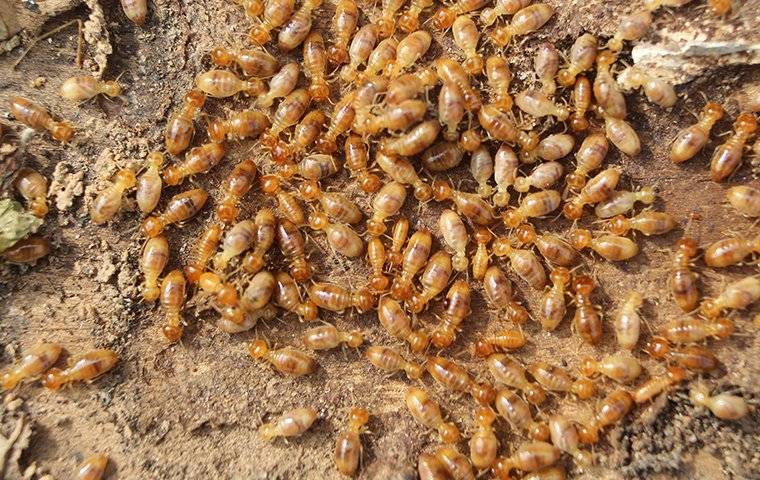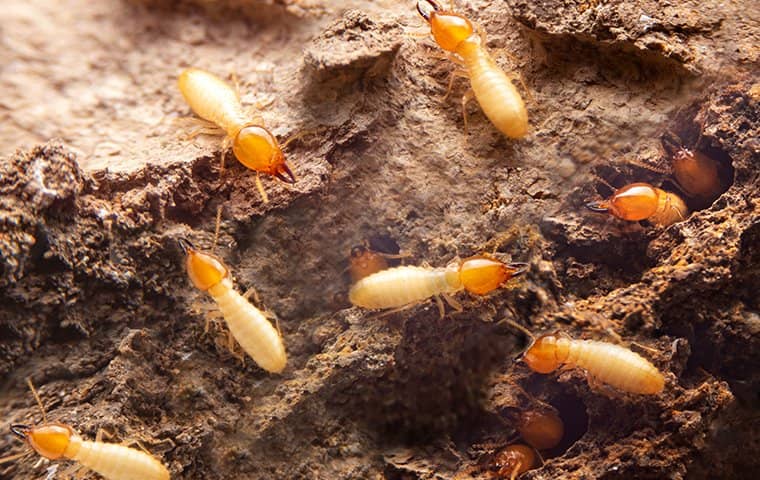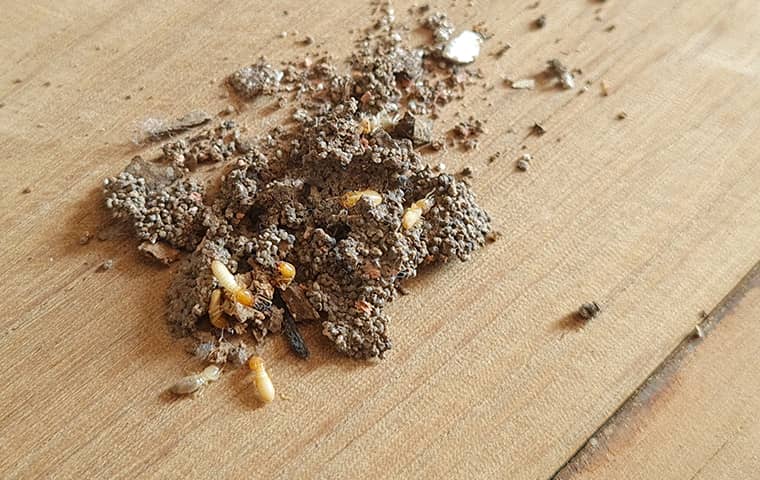Do you know that when you see a termite problem, you may not realize you're seeing a termite problem? It happens more than you might think. Sure, most people know what a termite looks like, but when you see one in real life, it appears to be little more than a tiny, six-legged insect. It is easy to shrug it off at that size as some other insect. Termite damage is also hard to identify. Moisture damage and termite problems go hand-in-hand, but sometimes, a moisture problem is just a moisture problem. If you have questions about how to unravel this mystery and accurately detect termites, you've found the article that will help.
In this guide, we'll tell you what professionals use to stop termites in their tracks and protect properties from termite damage. If you like the sound of that, read on. If you'd prefer a licensed termite control professional to guide you in selecting and installing your termite protection, we're happy to help.
Your Go-Forth Pest Control team doesn't just take care of termite removal in Raleigh; we also install advanced protection that proactively stops termite damage long before termites infest your yard. Connect with us by phone or online for guidance on termite solutions for your Raleigh property.


Identify: How To Identify A Termite Infestation
The most important way to protect your property from the tiny mouths of termites is to perform routine inspections. As you inspect your home, you need to know that it is challenging to find evidence of termites, and when you do find it, you may not realize it. Here's why.
Termite workers avoid conditions that might dry them out, such as coming out of their tunnels into the dry air. For this reason, they stay hidden. Most of the damage they do is on the inside of wood. You may need to tap the wood and see if it sounds hollow.
Termite workers do not like light. They don't want to come out of hiding even when conditions are humid enough because they avoid all light, even moonlight. Therefore, you'll only find any visible damage by termites in dark, damp locations, such as in a crawl space under a home. If you have a crawl space, that is a good location to inspect first. Look for these warning signs:
- Shelter tubes: These mud structures look like rivers of caked mud about a 1/4 inch thick.
- Splintered wood, trenches, or decaying wood with mud: There is typically mud associated with termite damage because they bring soil into their tunnels and make mud to use as a coating to hold moisture in.
- Worker termites: If you have objects stored in a crawl space or under a deck, you may find worker termites underneath them.
Termite swarmers don't mind the light and can tolerate dry conditions. If you're not familiar with them, swarmers are winged reproductive termites that gather into a swarm during their nuptial flight. But swarms last less than an hour, and these winged insects shed their wings and go into the ground to make new nests. If you find lots of uniform wings on the ground, that is a warning sign of a termite infestation.
It is tricky to find termite warning signs. Professionals use specialized technology and techniques to track activity. If you think you may have termites but aren't sure, contact Go-Forth Pest Control for a termite inspection in Raleigh. We can help you figure things out.
Signs Of Termite Infestations: How To Spot And Address Them
Some warning signs termites provide are not necessarily signs you'll look for in an inspection. Warning signs can just appear in front of you. When they do, you'll want to catch them and take steps to address the problem. Here are the signs.
Workers:
If you find workers on your property (or in a hiding place), you might mistake them for maggots, grubs, white ants, or some other creature. At 1/8 of an inch, these pale insects aren't much to look at. A good fact to remember is that worker termites will be in decaying wood, moist soil, and darkness. You've likely found termites when you pick up a dead branch from the damp ground and see a few tiny pale specks crawling around on the underside.
Swarmers:
If you see a termite swarm, you may have little doubt that you're looking at termites. Their long white wings are noticeable when they're swarming together. But you might see a swarmer by itself. You might notice one crawling on a walkway stone, your driveway, or your skin. A swarmer is 3/8 of an inch with a black body and white wings that stack on top of each other.
Wings:
If a termite swarm comes and goes, you may only have their shed wings as a sign. We pointed this out earlier. But you should know that you can stumble upon wings at any time. A common way you'll find wings is in a spider web underneath a structure. Spider webs act like sticky traps. Keep this in mind as you're pulling something out of an exterior storage location and notice a wing in a spider web. It could be a swarmer wing.
Damage:
While you can find signs of termite damage during an inspection, you may also uncover damage when you're not looking for it. You may do some construction, tear out a wall, and find wood with mud on it. You may pull out a stump in the yard and find trenching. You may notice that a dying tree has mud on it, is missing bark, or has a trunk that sounds hollow.
Clicking:
It is rare, but sometimes termites make detectable noises that sound like clicking or rattling. Termite soldiers make these clicking sounds. It is the subtle noise of their heads banging on tunnel walls to warn the workers of an invading enemy, such as ants.
If you catch the warning signs of termites on your property, what can you do about them? There are primarily two solutions for termite control—liquid termiticide and termite bait. These are the only methods that target the source of your problem, which is the colony generating the workers. Of the two, we recommend bait. But not all baiting systems are created equal. Let's take a look.
Baiting Systems For Termite Control: How They Work
Termiticide has been the solution used by termite control professionals for over a century, but there has been a move toward termite baiting systems in the last two decades. Professionals are switching to bait because it not only works to eliminate colonies but also provides effective termite monitoring. So, how do termite baiting systems work? Let's explore:
- A pro installs bait stations in the soil around a structure.
- When termite workers come searching for food, they find the bait.
- Termite bait is a desirable food source for termites and contains an active control ingredient that termites can't detect.
- When termites ingest the bait, they carry the active control ingredient back to the heart of the colony and feed the other termites.
- Exposure to the bait will result in the elimination of the termite colony.
Sounds simple, right? If only it were. You can't just go to the store and buy any termite bait product and get these results. Some products are head-and-shoulders above the others. One termite bait product is considered the #1 choice of professionals.
What Is The Most Effective Termite Control Method?
The most trusted system professionals use is The Sentricon® System with Always Active™. Unfortunately, this award-winning product is only available to certified termite technicians. You can't get this from the hardware store or online retailer. You have to hire a certified professional to install it.
The fact that only certified technicians have access to this system is one of the reasons this termite baiting system has such an incredible track record of success. Professionals have the training and experience to make sure things go as planned. It isn't enough to simply install the Sentricon® termite bait stations around a property. A certified termite control provider must evaluate many factors, swap out bait as needed, and interpret warning signs.
Do you live in Raleigh? Contact Go-Forth Pest Control for termite control near you. We are a certified Sentricon® Installer. We can inspect your property, evaluate the conditions present, install the Sentricon® System with Always Active™, and maintain the system to ensure ongoing termite protection for your property.
The most amazing benefit of termite control with the Sentricon® System is that you'll know if termites ever try to make a meal out of your home or business. Your technician will show you the evidence. Why is this helpful? Because termite control costs money—money you might not spend if you don't think termites present a threat to your property investment. Finding evidence removes all doubt that you've made a good decision and will inspire you to keep your termite control active.
Contact Go-Forth Pest Control today if you'd like to learn more about the Sentricon® System or to get termite control advice for your Raleigh property. We're here to help.





